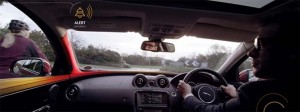Sometimes, it takes a tap on the shoulder to get your attention. That’s one way Jaguar Land Rover’s prototype Bike Sense system could help prevent collisions between cars and bicycles.
Bicycle deaths have been on the increase in recent years, in the U.S. rising nearly 20% between just 2010 and 2012, and most are the result of accidents involving a collision with a car. In the U.K., where Jaguar Land Rover is based, nearly 19,000 cyclists are killed or injured on the roads each year.
The carmaker has decided to address that problem with what could be a high-tech solution that would not only be able to spot a bicycle or motorcycle in harm’s way, but which would also take steps to advise a driver of the potential danger. The system under development would use lights and other warnings, even tap a driver on the shoulder, if necessary.
“Bike Sense takes us beyond the current technologies of hazard indicators and icons,” explains Wolfgang Epple, JLR’s Director of Research and Technology. The goal is to get a driver’s reaction more quickly by “engag(ing) the brain’s instinctive responses. If you see the dashboard glowing red in your peripheral vision, you will be drawn to it and understand straight away that another road user is approaching that part of your vehicle.”
(Why are bicycle fatalities rising? Click Here to find out.)
Instead of sounding a generic tone, researchers are programming the Bike Sense system with warning signals that a driver would more immediately associate with a bicycle. The audio system, for example, would make a sound much like a bicycle’s bell or a motorcycle’s horn coming through the speaker nearest the bike.
If a bike were approaching from the rear, the car seat would extend to tap the driver on the shoulder, something that instinctively causes a person to turn and look.
Then explains Jaguar, “As the cyclist gets closer to the car, a matrix of LED lights on the window sills, dashboard and windscreen pillars will glow amber and then red as the bike approaches. The movement of these red and amber lights across these surfaces will also highlight the direction the bike is taking.”
If all else fails, the system would make the accelerator pedal vibrate and the door handles buzz to keep the driver from pulling out or opening the door into the bike’s path.
The Bike Sense system is also capable of spotting a pedestrian or cyclist who might be obscured from view, perhaps by a parked vehicle, before crossing the street.
Jaguar Land Rover is but one of several manufacturers looking at ways to reduce car-bike collisions. The latest version of the Volvo City Safety forward collision warning system is sensitive enough to detect bikes, pedestrians and even large animals that might wander into a vehicle’s path.
The Swedish maker is also testing out a special bike helmet it has developed in cooperation with sports equipment manufacturer POC and electronics equipment giant Ericsson that would alert both a motorist and a bicyclist to a potential collision.
(For more on the Volvo bike safety system, Click Here.)
Jaguar, meanwhile, recently demonstrated another high-tech safety system that could make it easier to spot other cars, as well as bikes and pedestrians. Dubbed the “Virtual Windshield,” It would project images onto a vehicle’s pillars captured by outside cameras to make it look as if they were transparent, reducing blind spots.
Automakers, in general, are looking at a variety of technologies to make drivers more aware of unseen obstacles and dangers, and experts believe such advances could further reduce the already declining U.S. highway death rate.
(Click Here to check out the Jaguar Transparent Pillar system.)

